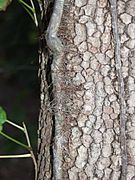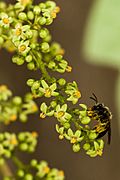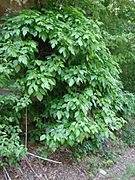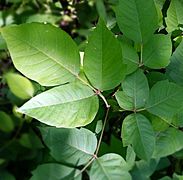Poison ivy facts for kids
Quick facts for kids Poison ivy |
|
|---|---|
 |
|
| Poison ivy fall coloration | |
| Scientific classification | |
| Kingdom: | Plantae |
| Clade: | Tracheophytes |
| Clade: | Angiosperms |
| Clade: | Eudicots |
| Clade: | Rosids |
| Order: | Sapindales |
| Family: | Anacardiaceae |
| Subfamily: | Anacardioideae |
| Genus: | Toxicodendron |
| Species | |
|
T. orientale Greene |
|
Poison ivy is a plant found in Asia and North America. It's famous for causing an itchy, irritating, and sometimes painful rash in most people who touch it. This rash is called urushiol-induced contact dermatitis. The rash happens because of urushiol, a clear liquid found in the plant's sap.
Even though it's called "poison ivy," it's not a "true" ivy. Instead, it belongs to the same plant family as cashews and pistachios. Poison ivy can look different depending on where it grows. Many animals eat Toxicodendron radicans, and birds enjoy its seeds. However, for most people, poison ivy is seen as an unwelcome weed.
Contents
Types of Poison Ivy
Scientists generally recognize three main types, or species, of poison ivy. Sometimes, these are considered different versions of the same species, Toxicodendron radicans.
- Toxicodendron orientale: You can find this type in East Asia.
- Toxicodendron radicans: This species grows across eastern Canada, the United States, Mexico, Central America, Bermuda, and the Bahamas.
- Toxicodendron rydbergii: This type is found throughout Canada and most of the United States, except for the southeastern parts.
What Poison Ivy Looks Like
Poison ivy plants can grow in different ways. They might be small plants, bushy shrubs, or even climbing vines. A key way to spot them is by their leaves. Each leaf cluster has three smaller leaflets. This is why people often say, "leaves of three, let it be!"
These leaflets can be shaped like an oval or an egg. Their edges might be smooth, wavy, or have small teeth. The leaf clusters grow in an alternating pattern along the stem. Small, greenish flowers appear from May to July. In the fall, these flowers turn into small, white berries, only a few millimeters wide.
Health Effects of Poison Ivy
The rash you get from poison ivy is an allergic reaction to urushiol. In very serious cases, some people can have a severe reaction called anaphylaxis. About 15 to 25 percent of people don't react to urushiol at all. However, most people will have a stronger reaction if they touch the plant more often or get a lot of the sap on their skin.
More than 350,000 people in the United States get a poison ivy rash each year.
Understanding the Rash
If you scratch the blisters, the liquid that oozes out does not spread the poison. This liquid is made by your body, not by the urushiol itself. If the rash seems to spread, it usually means some areas got more urushiol and reacted faster. It could also mean you are still touching objects that have urushiol on them.
You can accidentally spread urushiol around your house. It can get on phones, doorknobs, couches, counters, and desks. This can cause you to keep touching the poison ivy oil, making the rash last longer. If this happens, you should clean these surfaces with bleach or a special urushiol removal product.
The blisters and oozing happen because tiny blood vessels in your skin leak fluid. If you cool the skin, these vessels tighten and leak less. If poison ivy plants are burned, and you breathe in the smoke, the rash can appear inside your lungs. This can cause extreme pain and serious breathing problems. If someone eats poison ivy, it can damage the lining of their mouth and digestive system.
Urushiol oil can stay active for several years. This means even touching dead leaves or vines can cause a rash. Also, if the oil gets on other things, like pet fur, it can still cause a rash if it touches your skin. Clothes, tools, and anything else that has touched the oil should be washed to prevent more reactions.
Treating a Poison Ivy Rash
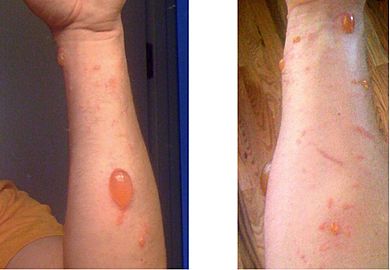
If you think you've touched poison ivy, wash your skin right away with soap and cold water. Using rubbing alcohol can also help prevent a reaction.
If you already have a rash, products like calamine lotion or diphenhydramine can help with the symptoms. For very severe cases, doctors might prescribe corticosteroids, which can be applied to the skin or taken by mouth. An astringent like Burow's solution can also help soothe the uncomfortable rash.
Urushiol sticks to your skin and causes severe itching. This leads to red inflammation, bumps, and then blisters. You can treat these spots with calamine lotion, Burow's solution compresses, special poison ivy itch creams, or even oatmeal baths and baking soda. These are often recommended by skin doctors.
Some people believe that a plant called jewelweed can help. However, studies haven't shown that jewelweed extracts are effective. The best way to avoid a rash is to wash your skin thoroughly with plain soap and a washcloth within 2 to 8 hours of touching the plant.
The allergic reaction is caused by chemicals called pentadecyl catechols found in the sap of poison ivy. When the plant is damaged, its sap leaks out. The urushiol in the sap turns into a blackish substance when it touches oxygen.
How Long Does the Rash Last?
Usually, a poison ivy rash lasts about five to twelve days. But in more serious cases, it can last a month or even longer. A rash from urushiol typically appears within a week of exposure. It can then last from one to four weeks, depending on how severe it is and if it's treated. In rare situations, a very bad urushiol reaction might require a hospital visit.
Plants Related to Poison Ivy
People who are sensitive to urushiol might also get a similar rash from mangoes. Mangoes are in the same plant family (Anacardiaceae) as poison ivy. The sap of the mango tree and the skin of mangoes contain a chemical similar to urushiol. A related allergic compound is also found in the raw shells of cashews. Similar reactions have sometimes been reported from touching the fragrant sumac (Rhus aromatica) and the Japanese lacquer tree. These plants are also part of the Anacardiaceae family.
Other Plants That Cause Rashes
Here are some other plants that can cause allergic reactions similar to poison ivy:
- Gluta spp (rengas tree)
- Lithraea molleoides (aruera – found in South America)
- Smodingium argutum (African poison ivy)
- Toxicodendron pubescens (poison oak – eastern type)
- Toxicodendron diversilobum (poison oak – western type)
- Toxicodendron vernix (poison sumac)
- Toxicodendron vernicifluum (Japanese lacquer tree)


